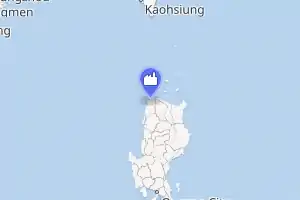Bangui Wind Farm
Bangui Wind Farm is a wind farm in Bangui, Ilocos Norte, Philippines. The wind farm uses 20 units of 70-metre (230 ft) high Vestas V82 1.65 MW wind turbines, arranged in a single row stretching along a nine-kilometer shoreline off Bangui Bay, facing the West Philippine Sea.
| Bangui Wind farm | |
|---|---|
 | |

| |
| Country | Philippines |
| Location | Bangui, Ilocos Norte |
| Coordinates | 18°31′40″N 120°42′50″E |
| Status | Operational |
| Commission date | June 20, 2005 |
| Owner(s) | NorthWind Power Development Corporation |
| Wind farm | |
| Type | Onshore |
| Hub height | 70 m (230 ft) |
| Power generation | |
| Units operational | 20 X 1.65 MW |
| Make and model | Vestas: V82 |
| Nameplate capacity | 33 MW |
| External links | |
| Commons | Related media on Commons |
Phase I of the NorthWind power project in Bangui Bay consisted of 15 of those wind turbines, each with a maximum production capacity of 1.65 MW of electric power, making a total of 24.75 MW. These 15 on-shore turbines are spaced 326 metres (1,070 ft) apart, each 70 metres (230 ft) high, with 41 metres (135 ft) long blades, with a rotor diameter of 82 metres (269 ft) and a wind swept area of 5,281 square metres (56,840 sq ft).
Phase II was completed on August 2008, and added five more of the same wind turbines, bringing the total maximum capacity to 33 MW.
Location
The Northwind Bangui Bay Project is located in the municipality of Bangui, Ilocos Norte, Philippines, at the north-west tip of Luzon island. The turbines face the sea from where the prevailing wind blows towards the land. Its location along the shore is optimal, due to a lack of windbreaks and limited terrain roughness. The site consists of 20 Vestas Wind Systems stretching 9 kilometres (5.6 mi) over the shoreline of the bay. The location of the Philippines near the Asia-Pacific monsoon belt is ideal for installing wind turbines.[1]
The Philippine Atmospheric, Geophysical and Astronomical Services Administration attests that the Philippines has a mean average of about 31 watts per square meter (W/m2) of wind power density.
History
In 1996, the National Renewable Energy Laboratory (NREL) conducted a wind resource analysis and mapping study. It concluded that various areas in the Philippines are ideal for wind power installation. These areas include Bangui and Burgos towns in Ilocos Norte, Batanes and Babuyan Islands, which are north of Luzon and the higher interior terrain of Mindoro, Samar, Leyte, Panay, Negros, Cebu, Palawan and Eastern Mindanao. The study led to the inception of the wind farm project. NorthWind Power Development Corp. developed (and maintains and operates) the project, while Vestas Wind Systems, a Danish firm, supplied the wind turbine-generator units (WTGs) for the site, similar to those already found in Denmark. The project was to have been developed in three phases, with Phase I of the project inaugurated on June 18, 2005 and attended by Former First Lady Imelda Marcos, then Governor Bongbong Marcos, Former DOE Secretary Vincent Perez, Undersecretary Peter Abaya and Dr. Robert Yap, Jesuit priest and Project Director of CD4CDM project of klima, who also conducted the invocation and blessing of the wind turbines.
Ratified by the NorthWind Power Development Corp and the International Bank for Reconstruction and Development through the World Bank Prototype Carbon Fund, the Northwind Bangui Bay Project was the first project in the Philippines to have the Emissions Reduction Purchase Agreement (ERPA) under the Clean Development Mechanism. The Bangui Bay Project is also the first Philippine recipient of the Carbon Emission Reduction Certificates (CER’s) from the Executive Board of the United Nations Framework Convention on Climate Change.
In 2006, the project produced a 5% discount of the weighted average price in the wholesale electricity spot market (WESM) or a generated savings of approximately US$1.4 million (PhP 70 million) for the INEC electricity consumers. The project cost for Phase I amounted to US$23 million.
Phase I consisted of 15 turbines, placed 326 meters apart, was completed on 7 May 2005, generating 24.74 megawatts. An additional 5 turbines brought the capacity to 33 megawatts, which was transmitted 5.7 km to an electrical substation in Laoag City. Connected to the Luzon Grid, the windmills supply 40% of Ilocos Norte's electricity needs. Each windmill is 70 m tall, with 41 m long blades.[1][2]
References
| Wikimedia Commons has media related to Bangui Wind Farm. |
- Cabie, Honor. "Ilocos Norte's windmills: Tourism and energy giants". Manila Standard. Retrieved 8 March 2020.
- "Wind power in Nangui Bay". Federal Ministry for the Environment, Nature Conservation, and Nuclear Safety. Retrieved 8 March 2020.

